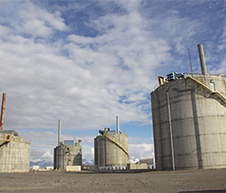NDAA Section 3116 Waste Incidental To Reprocessing (WIR) at The Idaho National Laboratory (INL) in Idaho – Calcined Solids Storage Facility (CSSF)
 |
Operator: U.S. Department of Energy |
Under Section 3116(b) of the Ronald W. Reagan National Defense Authorization Act for Fiscal Year 2005 (NDAA), the U.S. Nuclear Regulatory Commission (NRC), in coordination with the NDAA-Covered State monitors the U.S. Department of Energy (DOE) disposal actions to assess compliance with the NRC regulations in Title10 of the Code of Federal Regulations (10 CFR) Part 61, "Licensing Requirements for Land Disposal of Radioactive Waste," Subpart C, "Performance Objectives (POs)." The NDAA-Covered States are currently Idaho (ID) and South Carolina (SC).
The Idaho National Laboratory (INL) Site is an approximately 2,305 square kilometer (km)2 (890 square mile (mi2)) location owned by the U.S. Government that is in southeastern ID. The Idaho National Laboratory is located approximately 29 km (18 mi) from the nearest INL Site boundary.
There are seven calcined solid storage facilities (CSSF) designated as CSSF 1 – 7, at the INL CSSF, each containing three to twelve bin sets (CSSF bins). CSSF design is similar for all the bin sets. The design includes vertical stainless-steel bins inside a reinforced-concrete vault. The vault for CSSF 1 is rectangular and placed wholly underground. The vaults for CSSFs 2 - 6 are cylindrical and are located partially underground. In addition to housing the bins, there are interconnecting transfer piping, integral equipment, and containment.
Placed into service between 1963 and 2000, construction is different for each CSSF. CSSF 7 never received or stored calcine, and therefore calcine removal from CSSF 7 will not be required. CSSF bin heights range from 6.1 to 20.7 (20 to 68 ft), diameters ranging from 3.6 to 4.1 (142 to 162 in.), and construction materials of Types 304, 304L, or 405 stainless-steel plate. The reinforced-concreate storage vaults are also different for each CSSF. The CSSF 1 storage vault has inside horizontal dimensions of 7.8 x 7.8 (25.5 x 25.5 ft) and a height of 12.6 m (41.3 ft). The CSSF 2, 3, 4, and 6 storage vaults have an outer diameter that ranges from 15.2 to 18.6m (50 to 61 ft) and a height of 18.8 to 34 m (81.8 to 112 ft).
Approximately 4.4x106 Liters (1,162,000 gallons) of calcine is stored in CSSFs 1 through 6. Three of the six CSSFs are 100% full, the other CSSFs are 97% full, 99% full and 47% full. The DOE plans to remove residual calcine to the maximum extent possible from the CSSFs and associated ancillary equipment. Any residual calcine remaining after waste retrieval operations are complete will be stabilized with grout and remain in place at closure. It is anticipated that the INL CSSF will potentially be covered with an engineered cap, which will be determined at a later date.
Major NDAA WIR Consultation & Monitoring Documents For The INL CSSF:
| Document | Date | ADAMS Accession No. |
|---|---|---|
| NDAA Section 3116(a) Consultation Documents | ||
| DOE CSSF Draft Basis for Waste Determination | 10/03/2023 | ML23304A032 |
Current NRC Project Manager: Maurice Heath, 301-415-3137, Maurice.Heath@nrc.gov
Page Last Reviewed/Updated Wednesday, February 07, 2024
Page Last Reviewed/Updated Wednesday, February 07, 2024

